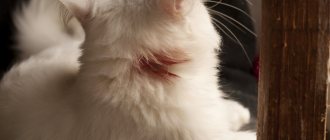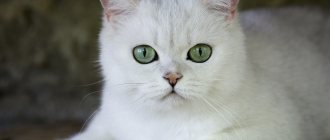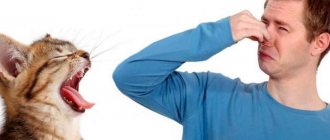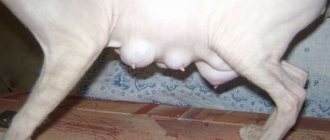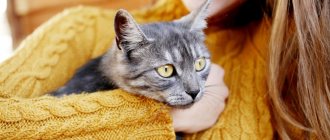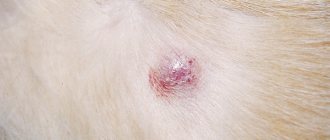When a pet begins to have serious problems with kidney function, this is a disaster for both the furry sufferer and his loving owner. Love for an animal means that the owner will study all the nuances of such a disease as kidney failure in cats, and learn everything about methods of treatment and prevention. So, we are studying the differences in the forms of this disease, how to diagnose and treat them.
What is kidney failure and why is it dangerous?
Kidney failure is very common in cats, although most often the disease manifests itself in older pets as chronic. Unfortunately, the kidneys also have their own resource.
global $ads_google; //data-ad-slot=”2475549904″ $ads_google = empty($ads_google) ? false : true; ?> if ($ads_google == false) {?>
$ads_google = true; ?> } ?>
Kidney disease is one of the most common medical problems in cats. Most often they manifest themselves in older animals in the form of chronic kidney disease, when the kidneys gradually exhaust their resources.
The disease comes in two forms:
- acute;
- chronic.
The second type of disease poses the greatest danger. We study:
Chronic renal failure
In the chronic form, gradual death of kidney cells occurs, which leads to a decrease in these organs in size and disruption of their functioning.
“Chronicle” is not curable, but if the correct therapy is carried out, then stopping the symptoms will significantly prolong the life of your beloved cat.
With this diagnosis, the pet’s condition is characterized as severe, and maintenance therapy cannot be avoided: the cat’s life will need to be maintained with special care and a special diet.
The disease requires regular monitoring by a veterinarian.
Acute renal failure
The acute type is reversible, because with timely treatment, success can be achieved with the complete elimination of all consequences of the disease.
Acute renal failure is a sudden dysfunction of the kidneys, or even its complete cessation. All renal functions are impaired: secretory, excretory, and filtration suffer.
Speaking about the condition of a sick cat, we can say that these will be symptoms of the disease that caused the kidney disorder.
It is difficult to express the initial phase in the clinical picture, because there are no characteristic symptoms as such. Secondary symptoms are disguised as the underlying disease, injury or poisoning. If you delay the start of treatment at this important moment, then you can “give” the cat oliguria (decrease) or anuria (when urine production completely stops).
In acute cases, the animal must be hospitalized immediately and proper treatment must begin. Delay will lead to complications or death.
Signs of the inevitable
Usually the animals become calm and lethargic. If a cat is really attached to you, then she is constantly caressed and tries to spend as much time as possible with the person. Even old cats, who have been “beeches” all their lives and have not particularly communicated with their owners, at the very end of their lives radically change their behavior.
It happens that even old cats that practically don’t walk anymore begin to play with their owner with the last of their strength and purr. This behavior does not indicate a “second youth”, but a premonition of the animal’s imminent departure. Use this time to play with your pet and try to pet him more often. Such signs indicate that you will not be together for long.
However, this is not always the case. If a cat dies from cancer or another serious illness, the death is most often silent. The animal no longer has any strength, and therefore it simply falls into unconsciousness and leaves.
Many people know that old cats often leave home shortly before their death. And in fact, this phenomenon is widespread: both domestic and foreign authors have written about it.
Causes of the disease
global $ads_google; //data-ad-slot=”2475549904″ $ads_google = empty($ads_google) ? false : true; ?> if ($ads_google == false) {?>
$ads_google = true; ?> } ?>
Owners of some breeds need to be more careful, as the incidence of kidney disease is higher in Persian and Angora cats. But often this is an acquired disorder that occurs for a number of reasons:
- as a result of decreased blood circulation and urine flow to the kidneys;
- high blood pressure levels;
- oncology;
- kidney stones create obstruction;
- poisoning by a number of medicinal and non-medicinal drugs;
- severe oral diseases;
- incorrectly selected diet with a large amount of phosphorus or high protein content.
The following can be said about the acute form. In prerenal acute renal failure, the cause may be shock after bleeding, poisoning, dehydration, or heart failure. There will be a drop in pressure and impaired circulation in the bloodstream of the kidneys. The causes of renal acute renal failure are called bacterial infections, inflammations and infections, poisoning with poisons and chemicals.
In postrenal acute renal failure, urolithiasis develops due to blockage of the urinary tract.
Risk group
The risk group includes such factors as the presence of kidney pathology, extensive injuries, serious illnesses, liver pathologies, inflammation of the pancreas, diabetes mellitus, diseases of the cardiovascular system, and hereditary insufficiency.
Cats over 7 years of age are also at risk, especially if they are in a prolonged state of dehydration or fever.
First aid for seizures
The main thing that the owner must do is to pull himself together and react without delay so that the cat does not have time to harm itself. Things are a little more complicated if kittens have a seizure. What to do in this situation:
- During a seizure, the cat may be injured, so you should remove surrounding objects that could injure the cat. The best option is to carefully, not tightly, wrap the animal in a blanket, and the kitten in a small sheet, so as not to provoke a fever;
- During an attack, the cat is in an inadequate state: it may not recognize its owners and may bite or scratch. Therefore, you should take care to protect your hands. Typically the spasm lasts about 5 minutes;
- after this you need to morally support the frightened pet. For example, gently stroke or communicate affectionately so that he reacts to the owner. The cat should not be left alone.
With a single episode of convulsive seizures, it is not necessary to call a doctor at home or go straight to the veterinary clinic. This can be done a little later if the pet does not show other signs of illness.
In severe cases, you should immediately go to the doctor. In this case, the animal must be isolated - be in a closed carrier.
Symptoms of the disease with photos
The symptoms of kidney failure are not so easy to understand. Especially in the chronic form of the disease.
Acute symptoms
If the cause is impaired renal function due to a developing infection, a state of shock, or obstruction of the lower urinary system, then the symptoms and signs of renal failure will be pronounced and the acute form will appear very clearly.
It is especially important if suddenly the cat constantly visits the toilet, but then such visits become rare, although the animal drinks water willingly and a lot.
global $ads_google; //data-ad-slot=”2475549904″ $ads_google = empty($ads_google) ? false : true; ?> if ($ads_google == false) {?>
$ads_google = true; ?> } ?>
At the same time, the cat may experience diarrhea, nausea or vomiting. This all leads to weight loss.
Externally, the pathology manifests itself in a deterioration in the quality of wool. The mucous membranes may turn red, swelling appears, and appetite disappears.
All these symptoms should immediately alert the owner and it would be best to take the patient and go with him to a veterinary hospital to make an accurate diagnosis.
Symptoms of the chronic form
The insidious variety is characterized by a hidden course, which greatly complicates the diagnosis without veterinary experience.
Signs of chronic renal failure include increased thirst with an increase in urine volume, simultaneous loss of body weight and loss of appetite. Vomiting may occur, and the general condition is lethargic. An unpleasant odor will be heard from the mouth.
Skin turgor becomes weak, folds do not straighten out for a long time. The temperature is lowered, the kidneys can be felt by palpation due to their increased size.
Diagnostics
Renal failure in cats can be reliably diagnosed if clinically possible. For diagnosis, you need to take a urine and blood test and undergo an ultrasound.
Laboratory studies are indicative. Blood biochemistry will reveal increased levels of creatinine, urea and other components, but calcium, on the contrary, will be reduced and acidity increased.
If this is acute renal failure, then a urine test will reveal protein and the presence of dead renal epithelium, glucose, and red blood cells. With chronic renal failure, urine will have a low specific gravity and density, protein will be very difficult to determine, but dystrophic cells of the tubular epithelium will be noticeable.
The results of a general blood test in the acute form will not show any peculiarities, but in the chronic form, anemia and an increased number of ESR will be revealed.
An ultrasound of the kidneys will show a changed structure of the organ, stones and tumors. If the form of the disease is acute, then the kidneys will be enlarged with edema, and in the chronic case, on the contrary, a strong decrease in the size of the organs and an uneven and clear contour will be shown.
It happens that a veterinarian suggests examining a pet for possible kidney problems even though there seem to be none. You shouldn’t refuse, because you can detect problems at an early stage, which significantly simplifies the situation and gives many chances for a cure.
global $ads_google; //data-ad-slot=”2475549904″ $ads_google = empty($ads_google) ? false : true; ?> if ($ads_google == false) {?>
$ads_google = true; ?> } ?>
At home, an accurate diagnosis cannot be made based only on symptoms.
Treatment of cat kidney failure
Since the condition of a cat with acute renal failure is different from the condition with chronic renal failure, the treatment processes will be different.
The most common sense decision if you suspect kidney failure in cats is to visit a veterinarian. Do not ignore the advice of a veterinarian:
If we are talking about an acute form, then intensive therapy will be carried out to remove toxins and combat dehydration.
If a chronic form is detected with damage to two-thirds of the kidneys, then treatment is prescribed only by a specialist.
Hospital treatment is prescribed for acute renal failure, as it is life-threatening. The process is designed for 10-14 days. Veterinarians will eliminate the main cause of the disease. If this is a blockage of the outflow of urine by a stone, then it will be removed by a catheter.
After this, the underlying pathology will be treated with intravenous infusions, which will eliminate problems with water-salt metabolism and acidosis. At the same time, cardiac activity, which suffers from excess potassium, is maintained.
Diuresis is stimulated, and sometimes peritoneal dialysis is performed to remove toxins. The abdominal cavity and drainages are involved in this - this will significantly reduce the load on diseased kidneys.
With inpatient treatment, the result can be the most positive with complete preservation of the functionality of the organs, but it is not particularly rosy if the patient gets to the doctors late. In this case, the cat faces a chronic form of the disease. The chronic form is treated in a hospital during relapses or complications.
In case of severe damage, kidney transplantation is possible.
A therapeutic diet will be prescribed, which will need to be strictly followed throughout the pet’s life. Even with serious damage, you can extend your pet’s life by three years, while alleviating its condition.
At home
global $ads_google; //data-ad-slot=”2475549904″ $ads_google = empty($ads_google) ? false : true; ?> if ($ads_google == false) {?>
$ads_google = true; ?> } ?>
At home, you will need to maintain your body and kidney function in the best possible condition. You will need to study the recommended cat diet and create a strict diet where the phosphorus content is minimal.
Everything else is done strictly according to the veterinarian’s recommendations, with frequent visits to the clinic, examinations and tests.
Drugs for renal impairment
It cannot be assumed that there is a general treatment regimen for everyone; it is selected taking into account the individual characteristics of each pet. Therefore, such schemes are changeable and aimed at precisely eliminating symptoms and causes.
In case of uremia, high intoxication from nitrogen metabolism products, a low-protein diet is introduced. In between meals, Ringer's solution or saline solution (0.9% NaCl) should be administered with a volume of up to 40 ml per 1 kg of body weight. Three administrations per day will be required.
If an excess of phosphorus levels in the blood is detected, then not only a diet is needed, but also the intake of phosphate binders that bind phosphorus. The drug is given with meals.
When the level of parathyroid hormone is elevated, calcitriol medications are prescribed.
Uncontrollable vomiting can be treated with Cerucal, but not on a permanent basis. It will be necessary to include histamine receptor blockers in the regimen: this is taking Famotidine, Cimetidine.
If there is acidosis, then the regimen cannot do without sodium bicarbonate and potassium citrate.
If high blood pressure is expressed, it is reduced in the absence of dehydration with Amlodipine, Enalapril.
The potassium balance is also brought back to normal; for this purpose, potassium preparations are introduced into the menu.
The kidneys are supported with drugs containing amino acids such as Lespenefril, Ketosteril, Chophytol, Canephron.
You can’t do without a vitamin component, sedatives, and if indicated, corticosteroids and diuretics.
Drug support
A sick cat will need constant medical support: not just pills or injections, but regular droppers that will restore water and mineral balance and reduce the toxic load on the kidneys, which will keep the remaining cells in a normal state. All medications must be prescribed by a veterinarian after the next examination: constant adjustment of the treatment regimen is important. The owner will be required to pay utmost attention to the dosage and schedule of medication.
With the development of renal failure, it is also necessary to constantly monitor the animal’s weight. In case of sudden weight loss, special prescriptions of anabolic steroids and vitamin complexes are necessary.
Cat diet and nutrition
Proper nutrition for kidney failure will significantly alleviate the cat’s condition, improve the pet’s quality of life and increase its duration. It is best to contact your veterinarian for a specific list of permitted products.
global $ads_google; //data-ad-slot=”2475549904″ $ads_google = empty($ads_google) ? false : true; ?> if ($ads_google == false) {?>
$ads_google = true; ?> } ?>
Special food is available for cats with this disease. Their composition is optimal as a food product. The phosphorus component must be limited, which will have a positive effect on the rate of organ destruction.
From ready-made food for kidney failure, you can purchase:
- Royal Canin Renal low phosphorus and protein;
- Hills Prescription Diet K/D Feline Renal Health with Omega-3;
- Farmina Vet Life Renal with the required protein content as a medicinal feed.
The composition of such feeds is balanced and optimal in content. You can purchase wet or dry food to suit your pet's taste. The advantage of this choice will be a ready-made selection of the amount of phosphorus and protein, which is very difficult to do when feeding natural products.
When a pet is fed natural food, the intake of sodium, which contributes to arterial hypertension, is limited. A cat can eat chicken breast, turkey, rabbit meat, and vegetables.
What to do at home
The owner must strictly follow the veterinarian's instructions. Self-medication and replacement of traditional methods of conservative treatment lead to detrimental consequences.
A sick pet needs to be provided with quality care and therapeutic nutrition. The diet lasts for at least six months. At this time, salt, sea fish, fatty meats, offal, cereals, and dairy products are completely excluded from the cat's menu. Flour products and fish oil are prohibited.
The diet consists of poultry (chicken, turkey), broth, vegetables (cabbage, carrots). There are few acceptable products, so veterinarians recommend giving preference to special medicinal dry food.
A product from Royal Canin, Renal food, developed for cats with renal failure, received high marks from experts. It includes all the vitamins and nutrients your cat needs during intensive care.
Forecasts
If the disease is detected in a timely manner and treatment is started on time, the prognosis is more favorable. If we are talking about the acute variety, then the situation is better: hospital treatment and a therapeutic diet can really work a miracle.
When they talk about the chronic variety, they immediately notice that everything depends on the pet’s immunity, supportive therapy, timeliness of treatment and the causes of the disease.
That is why it is important to realize the full responsibility for his life and follow all the veterinarian’s recommendations. In this case, the cat is able to live a longer life, full of love and care.
Video on the topic:


